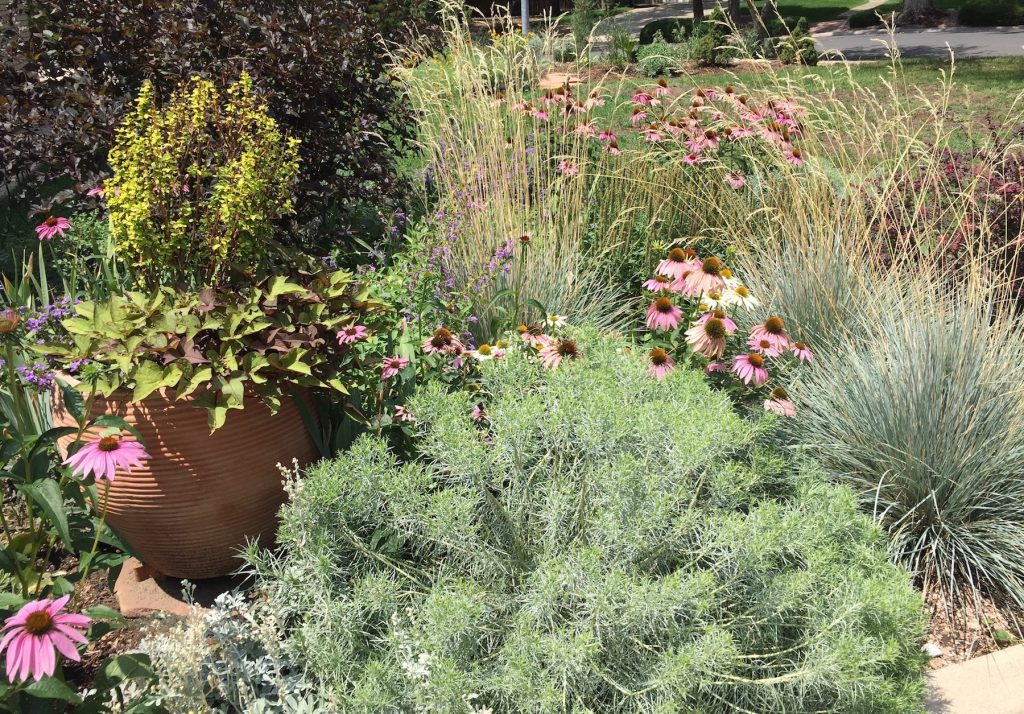Mulch: the magic M-word that every gardener should know and practice, in the garden and even in the conservatory.
Why mulch? Some may think that mulch is just cosmetic, improving the looks of a garden. That it does, but it’s main attraction is far more complex—and interactive set of attributes that keep the garden looking beautiful. Simply put, mulch conserves moisture in the soil, keeps root systems cool, suppresses weeds, and improves soil condition by adding organic matter as it decomposes. Plants just love mulch.

What kind mulch? Time was when the sine qua non of the mulch world was peat moss. But there are environmental concerns about harvesting peat bogs, stripping a natural biosystem to enhance an artificial one. In my part of the world, wood chip mulch, shredded pine bark, or rock of various grades—from pea gravel to boulder—spread in blankets across the soil, with plants poked in at three-foot intervals, bringing to mind the plaintive lyrics of Lonely Little Petunia in an Onion Patch.
While learning to garden in the Texas Hill Country, I got to know Scott Ogden (author with his wife Lauren Springer of several must-have books for anyone feeling daunted by their patch of earth). I was describing to Scott how laborious I found it to be constantly raking up the fallen leaves of the evergreen oaks in my garden. “Why do that?” he asked. “That’s nature’s mulch.” Forehead-smacking moment: I didn’t like to admit that it was fear of the HOA that kept me at it, because those leaves fall all the time. Yet I knew he was telling me just what I needed to do with the leaves—nothing. And that played right into my garden plan, which was going native. Goodbye lawn and aspidistras, hello buffalo grass and agaves (and lots of letters from the HOA, who approved of lawn and aspidistras, but native, not so much).

Fast forward fifteen years to Colorado Springs and my garden on a primeval sand dune, where I now do collect the leaves—silver maple this time—that drift in wet, slippery waves across the sidewalk, eddy in the gutters and around the foundations. But rather than plastic-bag them for curbside collection, I corral them in a wire pen to rot down for mulch. Sprinkled with the occasional scoop of compost accelerator, or chicken manure if I can get it, the mound rots down rapidly so I can use it around and between newly planted treasures. It doesn’t take much because, in fact, the plants serve as their own mulch, being planted much more closely together than is typical. Whether this is the result of over-enthusiastic shopping, or plantaholicism hardly matters. The simple fact this time is that small plants settle in more easily and grow to larger plants more quickly, where a large, container-grown plant planted in solitary splendor in a sea of mulch can take a while to establish itself as it supports a lot of top growth while trying to make roots. And as the small “starters” fill in, they cover the intervals between each other with expanding top growth, shading the soil and creating a moisture-retentive, cool understory to encourage new roots. Any weeds that do germinate are easy to pull, and as the plant leaves fade and drop they create nature’s own mulch. I have never noticed any sign of disease or pest infestation in my densely planted garden, perhaps because the plants are stronger because their roots go deeper, and are mutually supportive in their garden village. Furthermore, if plants are not cut down until the spring, the wilted top growth provides good winter cover at their base, and a refuge, too, for wildlife during the lean months.

However, if this sort of rich planting is not for you, pebbles, gravel and small grade rock is good mulch as it does all the things plant-sourced mulch would do. The trouble begins when there is too much mineral-derived cover, say, replacing lawn with a flood of river rock. On a hot day, the heat shimmers over the rock face of what should be a green garden oasis.
© Text and Photos, Ethne Clarke, 2018


